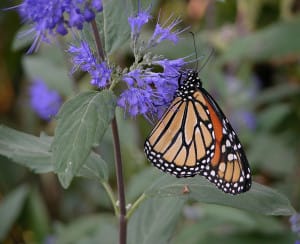Philly.com
by Sandy Bauers, Inquirer GreenSpace Columnist
 In a little less than 20 years, monarch butterflies — those orange icons of the garden — have declined more than 90 percent.
In a little less than 20 years, monarch butterflies — those orange icons of the garden — have declined more than 90 percent.
On Tuesday, several groups and long-time monarch scientist Lincoln Brower filed a legal petition to the U.S. Fish and Wildlife Service seeking Endangered Species Act protection for the species.
“Monarchs are in a deadly free fall and the threats they face are now so large in scale that Endangered Species Act protection is needed sooner rather than later, while there is still time to reverse the severe decline in the heart of their range,” said Brower in a press release. He has been studying the species since 1954.
The groups are the Center for Biological Diversity and Center for Food Safety, plus the Xerces Society, which focuses on invertebrate conservation.
The groups blame the butterfly’s dramatic decline on the widespread planting of genetically engineered crops in the Midwest, where most monarchs are born. (And, thus, the interest of the Center for Food Safety.)
According to the press release, “the vast majority of genetically engineered crops are made to be resistant to Monsanto’s Roundup herbicide, a uniquely potent killer of milkweed, the monarch caterpillar’s only food. The dramatic surge in Roundup use with Roundup Ready crops has virtually wiped out milkweed plants in midwestern corn and soybean fields.”
“The widespread decline of monarchs is driven by the massive spraying of herbicides on genetically engineered crops, which has virtually eliminated monarch habitat in cropland that dominates the Midwest landscape,” said Bill Freese, a Center for Food Safety science policy analyst. “Doing what is needed to protect monarchs will also benefit pollinators and other valuable insects, and thus safeguard our food supply.”
The population has declined from a recorded high of approximately 1 billion butterflies in the mid-1990s to only 35 million butterflies last winter, the lowest number ever recorded.
Likewise, the Cape May Monarch Monitoring Protect, which completed its 23rd field season of research last year, showed the third lowest average number of butterflies since the work began. They tallied 12.74 monarchs an hour — still quite a sight. I remember sitting on a beachfront deck at Barnegat, N.J., one year and watching them float by. But not the spectacle it once was, apparently.
For more about the Cape May project:
The project website is here.
The project blog is here.

